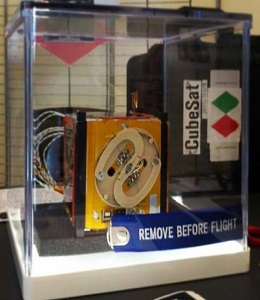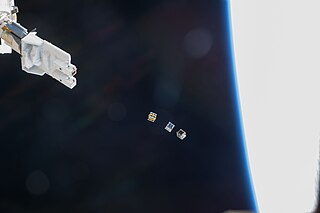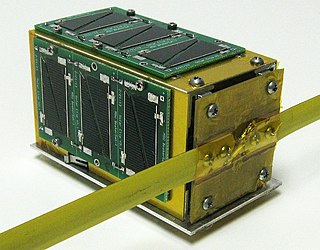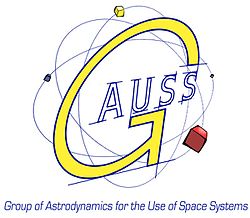
A CubeSat is a class of miniaturized satellite based around a form factor consisting of 10 cm (3.9 in) cubes. CubeSats have a mass of no more than 2 kg (4.4 lb) per unit, and often use commercial off-the-shelf (COTS) components for their electronics and structure. CubeSats are put into orbit by deployers on the International Space Station, or launched as secondary payloads on a launch vehicle. As of August 2021, more than 1,600 CubeSats have been launched.
RAIKO is a Japanese satellite which was built and operated by Tohoku and Wakayama Universities. A two-unit CubeSat, RAIKO was deployed from the International Space Station (ISS) on 4 October 2012, having been launched on 21 July 2012.

A small satellite, miniaturized satellite, or smallsat is a satellite of low mass and size, usually under 1,200 kg (2,600 lb). While all such satellites can be referred to as "small", different classifications are used to categorize them based on mass. Satellites can be built small to reduce the large economic cost of launch vehicles and the costs associated with construction. Miniature satellites, especially in large numbers, may be more useful than fewer, larger ones for some purposes – for example, gathering of scientific data and radio relay. Technical challenges in the construction of small satellites may include the lack of sufficient power storage or of room for a propulsion system.

The Dnepr rocket was a space launch vehicle named after the Dnieper River. It was a converted ICBM used for launching artificial satellites into orbit, operated by launch service provider ISC Kosmotras. The first launch, on April 21, 1999, successfully placed UoSAT-12, a 350 kg demonstration mini-satellite, into a 650 km circular Low Earth orbit.

SARAL is a cooperative altimetry technology mission of Indian Space Research Organisation (ISRO) and Centre National d'Études Spatiales (CNES). SARAL performs altimetric measurements designed to study ocean circulation and sea surface elevation.
Negai☆″ is a Japanese satellite which launched in May 2010. It is a student-built spacecraft, which will be operated by Soka University, and is intended to be used for technology demonstration. The satellite is a single unit CubeSat, and will be used to test a field programmable gate array in orbit. As part of an outreach programme, it will carry the names of selected children, along with wishes they have made. The satellite will return images of the Earth, which will be given to the participating children.

Several new rockets and spaceports began operations in 2016.

e-st@r was a miniaturised satellite built by the Politecnico di Torino. It was a 1U CubeSat design with a 10 cm side and a mass not exceeding 1.33 kg.
UniCubeSat-GG is a Miniaturized satellite built by the Sapienza University of Rome. It was launched into Low Earth Orbit on the maiden flight of Arianespace's Vega rocket on 13 February 2012. The launch was a multi-payload mission shared with LARES, ALMASat-1, Goliat, MaSat-1, PW-Sat, ROBUSTA, e-st@r and Xatcobeo.
SkySat is a constellation of sub-meter resolution Earth observation satellites owned by Planet Labs, providing imagery, high-definition video and analytics services. Planet acquired the satellites with their purchase of Terra Bella, a Mountain View, California-based company founded in 2009 by Dan Berkenstock, Julian Mann, John Fenwick, and Ching-Yu Hu, from Google in 2017.
A PocketQube is a type of miniaturized satellite for space research that usually has a size of 5 cm cubed, has a mass of no more than 250 grams, and typically uses commercial off-the-shelf components for its electronics.
EduSAT is an Italian microsatellite which was launched in August 2011. The satellite was built and is operated by the Sapienza University of Rome in conjunction with the Italian Space Agency ASI, and is primarily used for educational outreach and technology demonstration.

Planet Labs PBC is an American public Earth imaging company based in San Francisco, California. Their goal is to image the entirety of the Earth daily to monitor changes and pinpoint trends.

UniSat-6 is an Italian micro-satellite developed by GAUSS Srl and launched in 2014. The satellite is built in a 0.4x0.4x0.4m box-shaped bus, optimized for piggy-back launch. All instruments are powered by solar cells mounted on the spacecraft body, with maximal electrical power of 11W. The satellite has no on-orbit propulsion; it makes use of an attitude stabilization system based on permanent magnets.
Tancredo-1 was a Brazilian picosatellite. It was a TubeSat which was developed by the students from the school Tancredo Almeida Neves, in Ubatuba (SP), with support for the picosat platform made by Instituto Nacional de Pesquisas Espaciais (INPE), adapting and integration to launch provided by TuPOD from Italian company GAUSS Srl and by Agência Espacial Brasileira (AEB).

PicoDragon is a small satellite that followed the 1U type of CubeSat program built by the Vietnam National Satellite Center (VNSC) which belongs to VAST and operated in space for 3 months.
Sputnix is a privately-owned satellite construction company headquartered at the Skolkovo Innovation Center. It is one of Russia's first private space companies. It was founded in 2011 by ScanEx.
TigriSat is a CubeSat built in 2014 by a team of Iraqi students at the La Sapienza University of Rome. It uses an RGB camera to detect dust storms over Iraq, and transmits the data to ground stations in Baghdad and Rome. It is considered Iraq's first satellite. It was launched from Orenburg on June 19, 2014 on a Dnepr launch vehicle. It was deployed using a UniSat-6. As of July 2019, it remains operational.

$50SAT is an American amateur radio communications satellite. It was launched on November 21, 2013 with a Dnepr launch vehicle from the Dombarovsky Air Base, in Orenburg, Russia. It was part of the UNISAT-5 satellite program by GAUSS.













